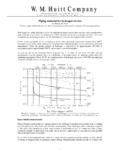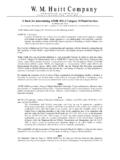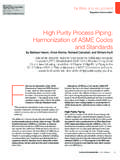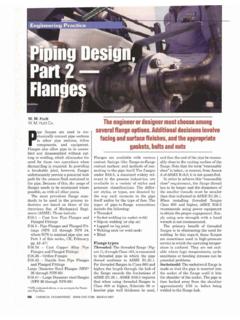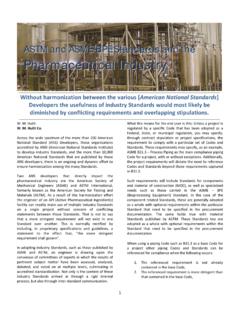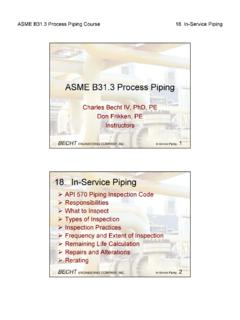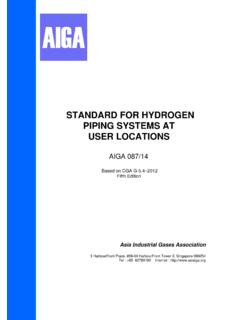Transcription of Leak Testing Properties - Pipe Design and …
1 P O B o x 3 11 5 4 S t . L o u i s, M O 6 3 1 3 1 - 0 1 5 4. Phone: (314)966-8919~E mail: Determining Code Compliance and pipe System Leak Testing by William M. Huitt (From a paper dated October 4, 2001 in response to leak test questions that were raised on a project). In determining the leak test requirements for piping systems a governing Code needs to be determined. The reason being that leak test requirements vary from Code to Code. In a March 12, 2001 letter I wrote, "The difference, and distinction, as to which Code should apply to a particular project lies with the definition and scope of the project itself. If, with respect to a particular project, the Design includes only the installation of a refrigeration system, would apply. If a project's scope of work consists of an office, laboratory, research facility, or any combination thereof, and possibly would apply.
2 A laboratory or research facility might also require fluid services beyond the range limits of In that case, would be adopted for those services only. "In the case of a process manufacturing facility, would be the governing Code. Since covers all piping, or would not be included, not even necessarily with associated lab, office and research facilities. The only time or would become governing Codes, in association with a manufacturing facility, is if a refrigeration unit, or an office, lab and/or research facility were under a separate Design /construct contract from the process manufacturing facility. Or they were a substantial part of the overall project. "As an example, project XYZ consists of a process manufacturing facility, office and lab facilities. If the utility service piping for the office and lab facilities is a small percentage of the overall project, and/or the Design and construction contracts for those facilities are a part of the overall process manufacturing facility, all piping, with Code exclusions, would be governed by "If, however, the office and lab facilities were a substantial part of the overall project it may be more beneficial to determine battery limits for those facilities and designate anything inside those battery limits as In such a case, separate pipe Schedules would have to be issued for those portions of the project designated as being governed by "For pipe Schedules that could be issued for both the portion of a project as well as the portion of a project a suffix, along with an edited statement within the pipe Schedule.
3 Would have to be added to the pipe Specification number. As an example, FA123 used for the portion of a project could be edited and identified as for the portion of the project. Once the governing Code is established for a piping system it will be necessary, except for refrigerant piping under ASME , to determine the Design conditions for each service. For refrigerant piping under ASME leak test pressures are predetermined based on the type of refrigerant used. However, for fluid services, other than Category D, under ASME and the leak test pressures will be determined based on deign pressure and temperature of the fluid. Determining the Design conditions (pressure/temperature) of an operating system is also required in determining the material of construction (MOC) and pressure rating classification for a piping system. ASME states, under Section - Design Pressure, in Para.
4 : (a) The Design pressure of each component in a piping system shall be not less than the pressure at the most severe condition of coincident internal or external pressure and temperature (minimum or maximum) expected during service except for allowable variations as described in para. (later); (b) The most severe condition is that which results in the greatest required component thickness and the highest component rating; (c) When more than one set of pressure-temperature conditions exist for a piping system, the conditions governing the rating of components conforming to listed standards may differ from the conditions governing the rating of components designed in accordance with para. 304. As a general rule the Design pressure is equal to the maximum anticipated operating pressure, plus 10% or 30 psi, whichever is greater. The Design temperature, for operating temperatures between 32 F and 750 F, 1.
5 Shall be equal to the maximum anticipated operating temperature, plus 25 F rounded off to the next higher 5 . The Codes that you will normally be working with are ASME , and And while is basically derived from the only leak test they agree on, somewhat, is the hydrotest requirement. Following are key points, relative to leak Testing , taken from the three primary piping Codes: : Hydrostatic Testing Required Hydrostatic Test Pressure. The hydrostatic test pressure at any point in the piping system shall not be less than times the Design pressure, but shall not exceed the maximum allowable test pressure of any non-isolated components, such as vessels, pumps, or valves, nor shall it exceed the limits imposed by para. (B). The pressure shall be continuously maintained for a minimum time as may be necessary to conduct the examination for leakage. Examinations for leakage shall be made of all joints and connections.
6 The piping system, exclusive of possible localized instances at pump or valve packing, shall show no visual evidence of weeping or leaking. Pneumatic Testing Preliminary Test. A preliminary pneumatic test not to exceed 25 psig may be applied, prior to other methods of leak Testing , as a means of locating major leaks. If used, the preliminary pneumatic test shall be performed in accordance with the requirements of paras. and Required Pneumatic Test Pressure. The pneumatic test pressure shall be not less than nor more than times the Design pressure of the piping system. The test pressure shall not exceed the maximum allowable test pressure of any non-isolated components, such as vessels, pumps, or valves, in the system. The pressure in the system shall gradually be increased to not more than one-half of the test pressure, after which the pressure shall be increased in steps of approximately one-tenth of the test pressure until the required test pressure has been reached.
7 The pressure shall be continuously maintained for a minimum time of 10 minutes. It shall then be reduced to the lesser of Design pressure or 100 psig and held for such time as may be necessary to conduct the examination for leakage. Examination for leakage detected by soap bubble or equivalent method shall be made of all joints and connections. The piping system, exclusive of possible localized instances at pump or valve packing, shall show no visual evidence of weeping or leaking. : Hydrostatic Leak Test Test Pressure. Except as provided in para. the hydrostatic test pressure at any point in a metallic piping system shall be as follows: (a) not less than 1 times the Design pressure;. (b) for Design temperature above the test temperature, the minimum test pressure shall be calculated by Eq. (24), except that the value of ST/S shall not exceed : PT.
8 S. where PT = minimum test gage pressure 2. P = internal Design gage pressure ST = stress value at test temperature S = stress value at Design temperature (c) if the test pressure as defined above would produce a stress in excess of the yield strength at test temperature, the test pressure may be reduced to the maximum pressure that will not exceed the yield strength at test temperature. Hydrostatic Test of Piping With Vessels as a System (a) Where the test pressure of piping attached to a vessel is the same as or less than the test pressure for the vessel, the piping may be tested with the vessel at the piping test pressure. (b) Where the test pressure of the piping exceeds the vessel test pressure, and it is not considered practicable to isolate the piping from the vessel, the piping and the vessel may be tested together at the vessel test pressure, provided the owner approves and the vessel test pressure is not less than 77% of the piping test pressure calculated in accordance with para.
9 (b). Pneumatic Leak Test Pressure Relief Device. A pressure relief device shall be provided, having a set pressure not higher than the test pressure plus the lesser of 50 psi or 10% of the test pressure. Test Pressure. The test pressure shall be 110% of Design pressure. Procedure. The pressure shall be gradually increased until a gage pressure which is one- half the test pressure or 25 psi is attained, at which time a preliminary check shall be made, including examination of joints in accordance with para. (a). Thereafter, the pressure shall be gradually increased in steps until the test pressure is reached, holding the pressure at each step long enough to equalize piping strains. The pressure shall then be reduced to the Design pressure before examining for leakage in accordance with para. (a). Initial Service Leak Test. This test is only applicable to piping in Category D fluid service, at the owner's option.
10 Test Fluid. The test fluid is the service fluid. Procedure. During or prior to initial operation, the pressure shall be gradually in steps until the operating pressure is reached, holding the pressure at each step long enough to equalize piping strains. A preliminary check shall be made as described in para. if the fluid is a gas or vapor. There is also a Sensitive Leak Test, which I won't go into here. I have called for this test in earlier letters and in the new Section 15114 Cleaning and Testing of pipe , for hydrogen service. Additionally there is a Hydrostatic-Pneumatic Leak Test and an Alternative Leak Test, which I won't go into. In trying to focus on the basic Testing procedures I didn't want to try and cover too much. If information on the other tests is needed I can follow up. Hydrostatic Testing Hydrostatic Test Pressure. (a) Minimum Pressure.
